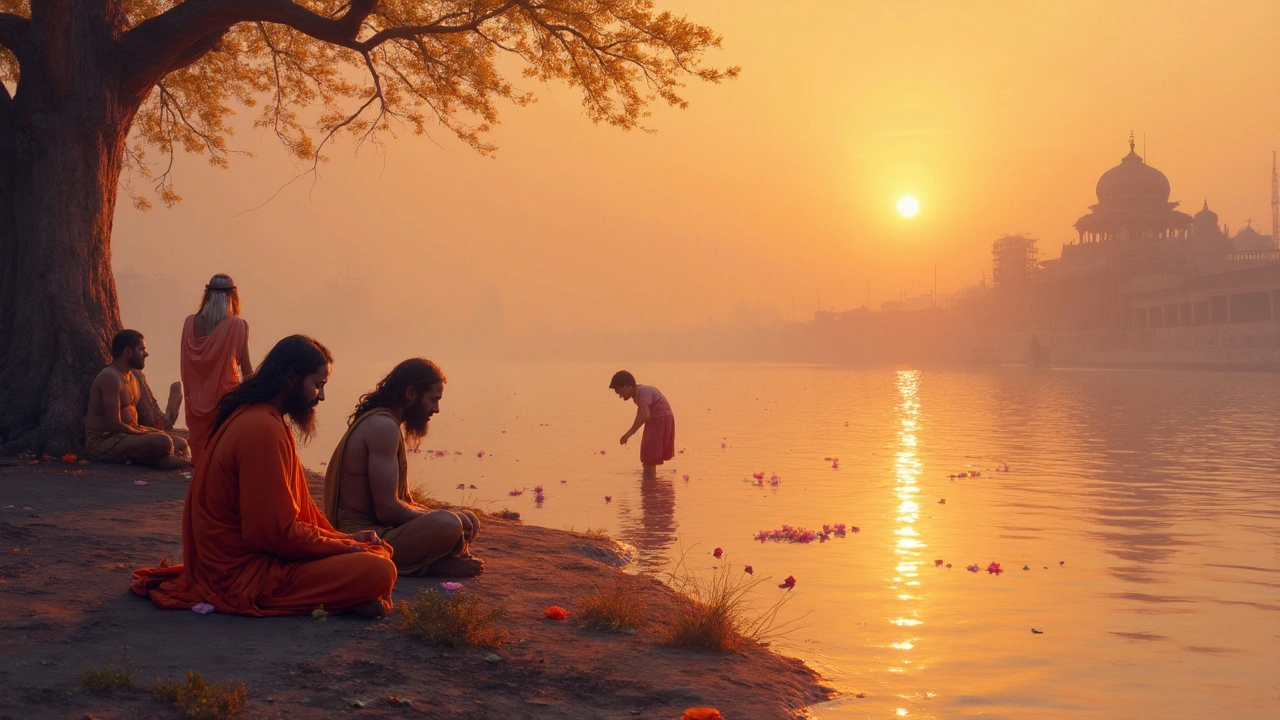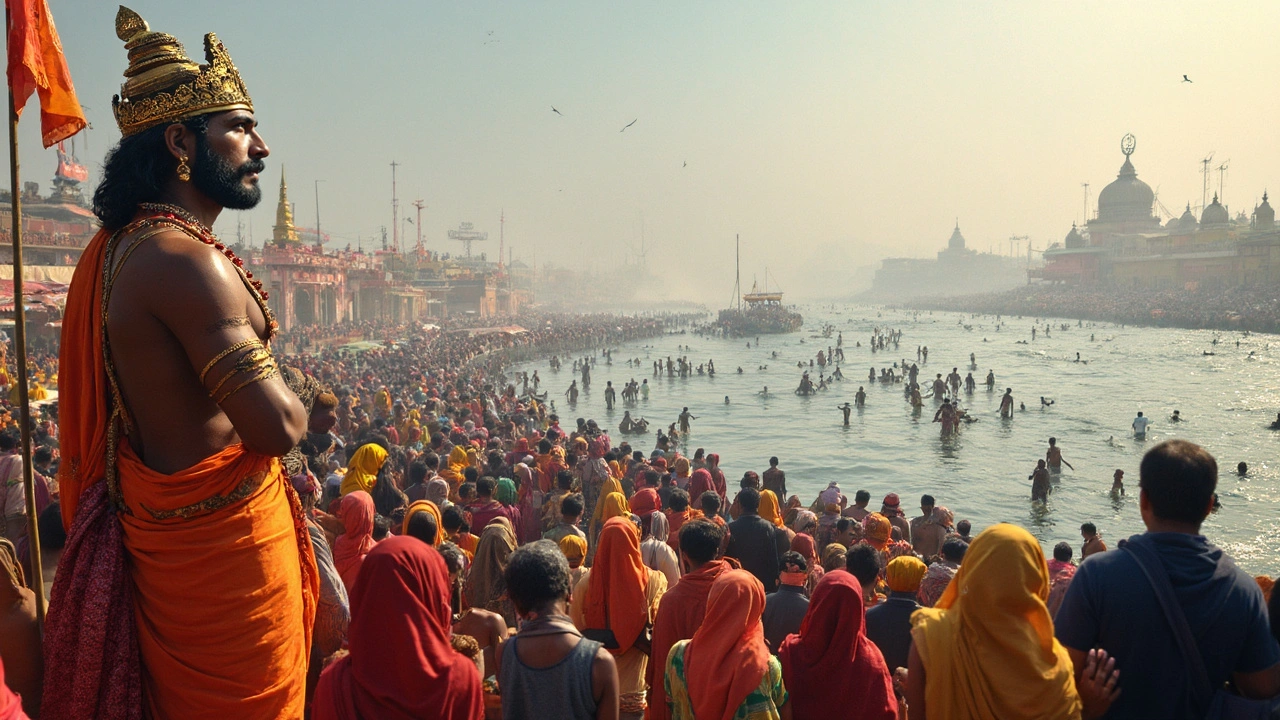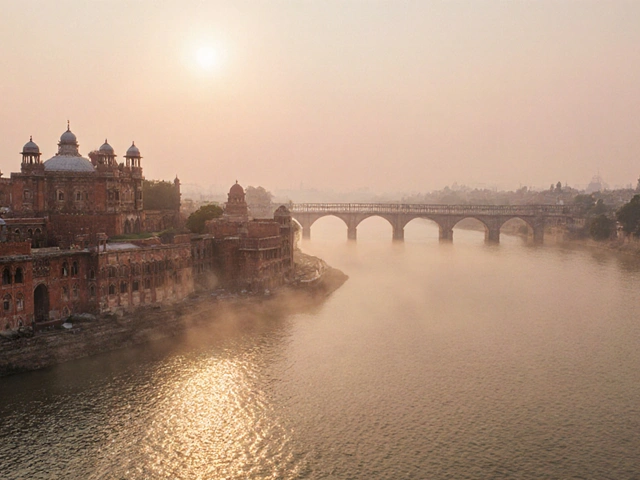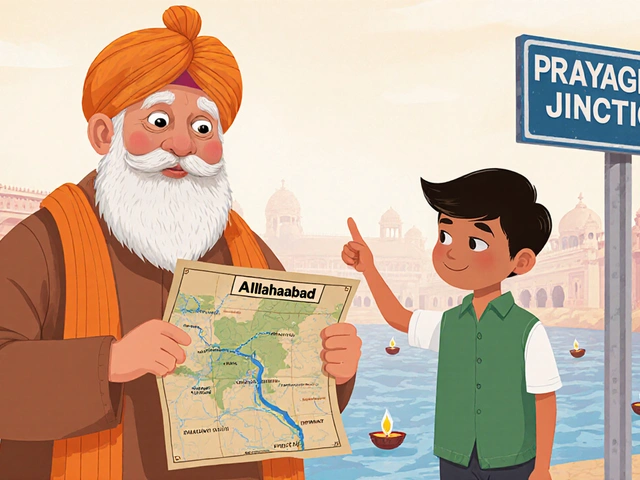Which God is Worshipped in Prayagraj?
Prayagraj, often buzzing with spiritual energy, is a place where history and devotion seamlessly blend. Known to many as Allahabad before its renaming, this city sits cozily at the confluence of the Ganges, Yamuna, and the mystical Saraswati river, a spot famously called the Sangam.
When it comes to worship, the standout deity here is Lord Hanuman, revered in the spectacular Bade Hanuman Ji temple. This particular deity is unique because it lies in a reclining position, unlike the usual standing or sitting postures found elsewhere in India. Locals and travelers alike flock to witness this unusual figure and seek blessings.
One cannot talk about Prayagraj without mentioning its claim to fame, the Kumbh Mela, which happens every 12 years. It attracts millions who come to take a holy dip at the Sangam, hoping to cleanse themselves of sins. This festival brings the spirit of devotion to a peak, with sadhus or holy men adding a distinct color to the atmosphere.
Historical Overview
The history of Prayagraj is as rich and layered as its spiritual legacy. This ancient city holds a special place in Indian history, primarily due to its strategic location at the Sangam. Prayagraj's roots can be traced back to the Vedic era, where it was celebrated as the “Tirtha-Raja” or the 'King of Pilgrimage centers.' It's mentioned in many ancient texts, including the Rigveda, which is one of the oldest scriptures known to mankind.
The Mughal Influence
Fast forward to the 16th century, the city was given the name Allahabad by Emperor Akbar. He recognized the city's strategic military and cultural importance, setting up a fort which still stands today at the confluence, showcasing stunning Mughal architecture. During the Mughal era, Ahmedabad (Prayagraj's former name) was a bustling center of art and culture.During the British Raj
In the British period, Prayagraj became a pivotal administrative city due to the influence of the East India Company. It was here that the first session of the Indian National Congress was held in 1885, planting the seeds for India’s struggle for independence.A lesser-known fact is that Prayagraj was a significant hub for the Nehru family, a prominent family in Indian politics. Anand Bhavan, the ancestral home of the Nehrus, is a famous landmark, attracting history buffs from around the globe.
Today, the blend of ancient and modern influences is evident throughout the city's architecture, culture, and social fabric. It's a place where history isn't just told through books but lives in the streets where everyday life unfolds.
Significance of Lord Hanuman
In Prayagraj, Lord Hanuman carries a unique stature both spiritually and culturally. The local temple, dedicated to this powerful figure, is a beacon for devotees from all walks of life. This isn't just any Hanuman temple—it's the famous Bade Hanuman Ji. What sets it apart? Well, the deity is in a reclining form, which is quite rare and offers a different spiritual experience.
Why the Reclining Posture?
This unusual posture symbolizes rest and repose, offering a sense of peace and assurance to worshipers. The reclining Hanuman is believed to be guarding the city, offering protection and strength. It's not only a symbol of might but also speaks to the heart of everyday visitors looking for comfort and courage.
The Temple Experience
Visiting the Bade Hanuman Ji temple is more than just a religious errand—it's an adventure into local faith and culture. The temple buzzes with life, especially during Tuesdays and Saturdays when special prayers are held. The rituals are simple yet effective—emphasizing internally chanted mantras and offerings like garlands and sweets. Even for non-followers, the atmosphere is captivating.
A study conducted by local historians shows that the temple attracts over 10,000 pilgrims weekly. This number skyrockets during festivals, demonstrating Hanuman's significance in the hearts of many.
Role in Kumbh Mela
The temple becomes a pivotal point during the Kumbh Mela, one of the largest religious gatherings on the planet. The festival amplifies the city's spiritual intensity, making Lord Hanuman's presence even more profound. Devotees believe that paying homage to Hanuman during this period multiplies the blessings, adding a divine layer to the Kumbh experience.
Lord Hanuman isn't just a deity here; he's a symbol of unwavering faith. His temple stands as a testament to age-old traditions and deep-rooted beliefs, making Prayagraj an unmissable destination for both spiritual seekers and cultural enthusiasts.

The Sacred Sangam
If there's one spot that holds the heart and soul of Prayagraj, it's the sacred Sangam. This isn't just any meeting point; it’s where the mighty Ganges and the Yamuna come together with the mystical Saraswati. This confluence is thought to hold immense spiritual energy, attracting people seeking redemption and peace.
The Sangam is a vibrant hub of activity, especially during major Hindu festivals like the Kumbh Mela and Magh Mela. Pilgrims believe that a dip in these conjoined waters can wash away lifetimes worth of sins. It's quite a sight to behold – a sea of humanity, sadhus with their ash-smeared bodies, and the chanting of devotional songs.
Planning a visit?
If you're considering a trip, the best time to visit is during one of these festivals, especially Kumbh Mela. While it's chaotic, the experience is unparalleled. Do gear up for massive crowds; we're talking millions. And remember to keep valuables close. But honestly, being part of such an age-old tradition is worth every bit of hassle.
Getting to the Sangam
Reaching the Sangam is relatively straightforward. Once in Prayagraj, you can easily hop on a local rickshaw or cab. Most drivers know their way, so directions shouldn't be an issue. If you're the adventurous type, a walk over the pontoon bridges can be thrilling, offering some stunning views of the waters beneath.
While at the Sangam, consider hiring a boat for a more scenic view. Boatmen, often doubling as friendly guides, can give you some fascinating insights into the place's legends and history.
Travel Tips for Visitors
Planning a trip to Prayagraj involves a bit of prep work, but it’s so worth it. Here’s how to make the most of your visit:
When to Visit
Prayagraj can be quite a scene, especially during the Kumbh Mela. Millions gather, so unless you’re there for the festival, consider visiting from October to March. The weather is cooler and more comfortable compared to the peak summer months.
Getting Around
The city is well-connected by road and rail. For local travel, auto-rickshaws and taxis are convenient. Don’t shy away from using public transport if you want to save a bit. Apps like Ola and Uber operate here, which can make getting around smoother.
Must-See Spots
- Bade Hanuman Ji Temple: Known for its reclining Hanuman statue. Don’t miss it!
- Sangam: The confluence is a spiritual landmark. It's where you’ll see people taking ritual baths.
- Anand Bhavan: Dive into history at the ancestral home of the Nehru-Gandhi family.
Local Eats
Don’t leave without trying the local street food. Prayagraj offers mouth-watering chaat, samosas, and sweet treats like jalebi. These are budget-friendly and give you a true taste of the city.
Safety Tips
- Keep your belongings secure, as public areas can get crowded.
- If visiting during the Kumbh Mela, stick to groups and be mindful of directions.
- Stay hydrated, especially if you’re exploring during the warmer months.
Useful Contacts
| Service | Contact Number |
|---|---|
| Police | 100 |
| Ambulance | 102 |
| Tourist Helpline | 1363 |
These travel tips should help make your adventure to Prayagraj smooth and fun. Remember to carry your camera for those Insta-worthy shots!





10 Comments
Tamil selvan
July 17 2025I must say, this post beautifully captures the spiritual essence of Prayagraj—formerly Allahabad. The mention of Lord Hanuman, or Bade Hanuman Ji, as a significant figure for locals and pilgrims alike, is quite illuminating. Of course, the Sangam, the confluence of the Ganges, Yamuna, and the mythical Sarasvati rivers, adds a deep sense of sacredness to the city.
This convergence isn’t only geographical but also symbolic of unity and spiritual cleansing, which attracts millions during the Kumbh Mela. It’s essential to appreciate how these traditions weave into the daily lives of those who visit and dwell there. It would be really interesting to explore how the worship practices of Bade Hanuman Ji differ from those of other regional Hanuman forms—or indeed from other deities revered across India.
Thanks for bringing attention to this deeply cultural and religious tapestry!
Sarah Meadows
July 17 2025While the post highlights Lord Hanuman's worship in Prayagraj, we cannot deny that such places represent the very heart of Hindu nationalism and spiritual pride. The Kumbh Mela is not just a festival but a powerful assertion of India's deep-rooted religious heritage reflecting Vedic traditions.
Understanding this is crucial in a world increasingly dominated by western secularism, which often fails to grasp the symbolism of these sacred practices and deities. Lord Hanuman epitomizes strength, devotion, and protection, qualities that Indian society rightfully venerates in the face of global cultural dilution.
Prayagraj, as a spiritual capital, should be recognized as a beacon for preserving our indigenous dharmic values. No other culture holds such a magnificent blend of ritual, myth, and endurance.
VIRENDER KAUL
July 18 2025It is imperative to adopt a more critical lens when assessing the worship patterns in Prayagraj. While Lord Hanuman's veneration is undoubtedly prominent, one should not disregard the political undercurrents influencing the religious narrative. The glorification of Bade Hanuman Ji often aligns with a resurgence of a certain ideological agenda, which tends to overshadow the pluralistic and multi-religious fabric that historically characterized Prayagraj.
Moreover, the Kumbh Mela, albeit a religious spectacle, has been commodified, diluting its original spiritual intentions. The Sangam, while a natural confluence, has been transformed into a spectacle inviting monetary and political exploitation under the guise of religious festivals.
It behooves us to question the motivations and the evolution of such worship practices beyond their apparent sanctity.
OONAGH Ffrench
July 18 2025Considering the information presented, the confluence or Sangam serves as a profound symbol beyond physical geography. The worship of Bade Hanuman Ji in Prayagraj intertwines with this confluence, highlighting the unity of diverse energies and narratives.
In Hindu philosophy, deities manifest various aspects of the divine; Hanuman represents devotion and selfless service. His significance at Prayagraj underscores collective spiritual striving.
One might reflect on how these layered meanings shape the experience for the pilgrims who gather here. It’s a remarkable demonstration of living traditions adapting over centuries yet remaining relevant.
Wilda Mcgee
July 25 2025What stands out to me is the unique relationship the city has with its river confluence and the deity Hanuman. It’s as if the landscape and mythology merge to create a vibrant cultural mosaic. For many, Hanuman is more than a god; he’s the embodiment of courage and loyalty.
The Kumbh Mela, with its million-strong crowds, becomes a living testament to faith and human endurance. I wonder, though, how the modern changes in the city influence these devotional traditions. Are younger generations maintaining these rituals with the same fervor? It would be wonderful to know.
I truly appreciate this post bringing the spotlight to such a heartfelt aspect of Indian spirituality.
Chris Atkins
July 30 2025Interesting post! Prayagraj’s religious significance through its Sangam really can’t be overstated. It's one of those places where geography and faith intersect in such a compelling way. And yes, my understanding is Lord Hanuman, especially the form known as Bade Hanuman Ji, acts as a spiritual protector for the city.
I’d be curious to know, does the worship extend beyond the Hindu faith in terms of local cultural influence? Sometimes these sacred sites have subtle layers involving multiple traditions and communities.
Thanks for sharing this insight, it’s always fascinating to learn more about the world’s spiritual hubs.
Jen Becker
July 30 2025Ugh, this is all so overhyped. Everyone talks about the Kumbh Mela like it’s this sacred event that changes lives forever, but honestly, the whole thing feels just like a tourist circus. Bade Hanuman Ji or not, it’s the same old story repeated year after year.
I get that it’s important culturally and spiritually to some, but let’s not pretend it’s not a massive crowd-pulling show event. Devotion doesn’t need to be so flashy to be real. Sometimes I wonder if the actual spiritual depth gets lost in all the pomp.
Maybe I’m just skeptical but it’s worth questioning the commercial and media frenzy around such events.
Ryan Toporowski
August 7 2025Just wanted to add a quick thought here :) I think the devotion to Bade Hanuman Ji in Prayagraj really inspires a lot of people to practice resilience and courage in daily life. The symbolism of the three rivers coming together reminds me that, much like those waters, diverse energies and faiths can unite harmoniously.
It's heartening to see such vibrant traditions persist in modern times, keeping the spiritual vibe alive. Thanks for sharing this post — it’s a cool reminder of the power of faith and nature interacting.
Samuel Bennett
August 9 2025Hmm, while the post praises the worship of Lord Hanuman in Prayagraj, I can’t help but wonder if sometimes these narratives are too neat, ignoring the complexity of religious practices. Are we certain that Bade Hanuman Ji holds universally dominant status, or is this somewhat politicized?
Also, the usage of the name 'Bade Hanuman Ji' might be regional, implying that the figure resonates differently across states and casts. It’d be interesting to see a deeper look into regional variations and how they influence religious expression during grand events like Kumbh Mela.
Without such scrutiny, we risk accepting oversimplified stories that serve convenient cultural myths.
Rob D
August 14 2025Clearly, Lord Hanuman as Bade Hanuman Ji in Prayagraj symbolizes the fighting spirit of India’s heritage. I think many underestimate the importance of such deities in maintaining national identity amidst global distractions. The Kumbh Mela’s immense scale is a testament to this enduring faith.
This isn’t mere superstition but a powerful cultural anchor. Also, the Sangam’s spiritual significance overlaps with nationalist narratives that regard reclaiming India’s sacred geography as vital to its future.
The post is timely, often such crucial topics go unnoticed in the current media landscape dominated by superficial news.